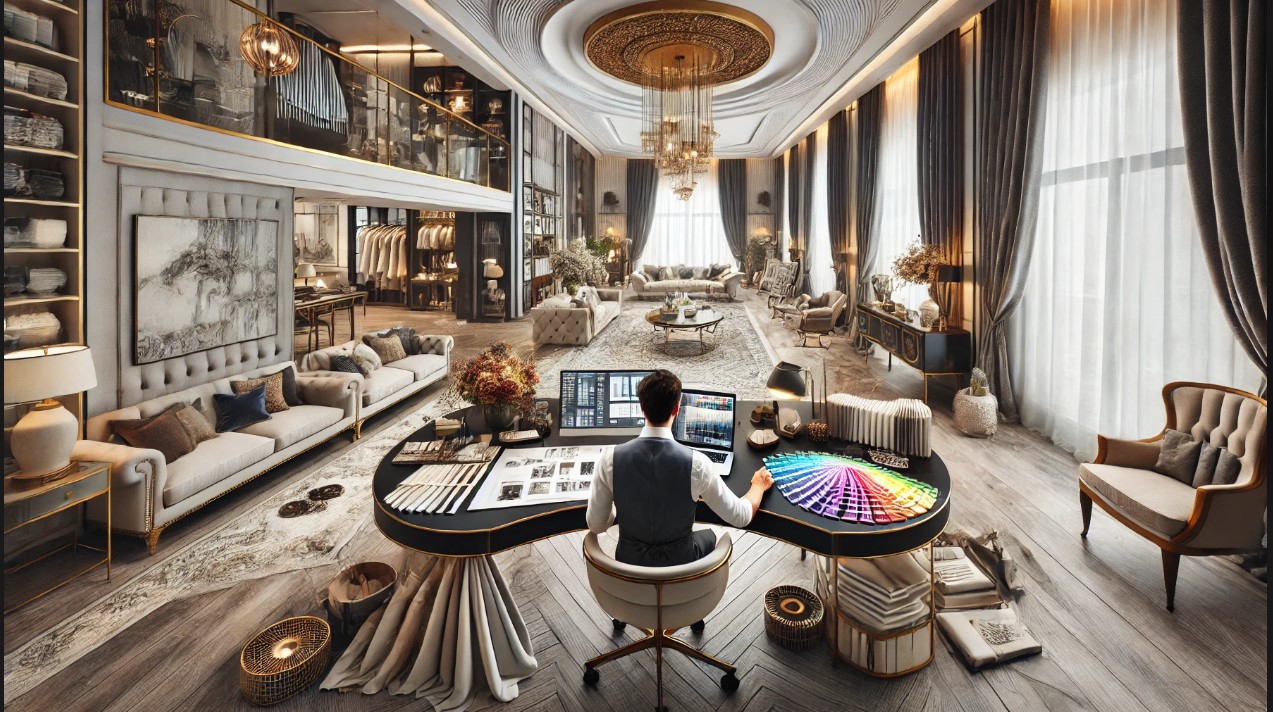Interior design is more than just arranging furniture or selecting colours; it’s an art that transforms spaces into functional, aesthetically pleasing environments.
Whether you’re considering a career in interior design or you’re already an established professional, understanding how income varies between freelance and full-time roles is crucial. These two career paths not only differ in terms of salary but also in flexibility, job security, and growth opportunities.
In this blog, we’ll explore the average salary for interior designer in the UK, compare freelance and full-time earnings, and provide tips for maximising your income in this rewarding field.
What is the Average Salary for Interior Designer in the UK?

In the UK, interior designers can expect an average salary ranging from £23,000 to £45,000 per year, according to the National Careers Service. Entry-level designers, or starters, typically earn around £23,000 annually, while experienced professionals can make up to £45,000 or more, especially in specialised fields or senior roles.
Interior designers generally work 37 to 42 hours a week, although this can vary depending on workload, projects, or employment type.
Key Factors Influencing Salaries
- Experience: Senior designers with 5+ years of experience earn significantly more.
- Location: Designers in London and other major cities often command higher salaries.
- Specialisation: Expertise in niche areas like sustainable design or luxury interiors can boost earnings.
Which UK Cities Offer the Highest Salaries for Interior Designers?
Location significantly impacts the earning potential of interior designers. The table below highlights the highest-paying cities for interior designers in the UK based on average annual salaries:
| City | Average Salary (per year) |
| Bedford | £77,448 |
| West London | £45,321 |
| London | £43,842 |
| South West London | £42,967 |
| Manchester | £38,612 |
| Edinburgh | £35,955 |
| Birmingham | £35,902 |
| Bristol | £35,695 |
| Glasgow | £35,492 |
Designers based in Bedford earn the highest average salary, with London and its surrounding areas also offering competitive compensation.
How Much Do Full-Time Interior Designers Earn in the UK?

Full-time roles offer a steady income, typically ranging from £25,000 to £40,000 annually, with senior designers earning up to £50,000 or more.
Benefits of Full-Time Roles
- Job Security: Regular paychecks and employee benefits, including health insurance and pension schemes.
- Career Progression: Opportunities to climb the corporate ladder and take on managerial roles.
- Structured Work Environment: Predictable schedules and access to resources for professional growth.
Challenges
- Limited flexibility in work hours.
- Less freedom in choosing projects compared to freelancing.
What Are the Earnings for Freelance Interior Designers?
Freelance interior designers in the UK earn anywhere from £20,000 to £60,000 annually, with top-tier freelancers surpassing this range. However, these figures depend heavily on the designer’s ability to source clients and projects.
Factors Influencing Freelance Earnings
- Client Base: A strong network can lead to consistent work and referrals.
- Market Demand: High-demand designers specialising in unique niches can command premium rates.
- Project Scope: Larger, more complex projects offer higher payouts.
Freelancing offers greater flexibility but comes with financial unpredictability.
How Do Freelance and Full-Time Roles Compare in Terms of Salary?

While full-time roles provide financial stability, freelancing often allows for higher earning potential.
| Aspect | Freelance | Full-Time |
| Average Salary | £20,000–£60,000+ | £23,000–£50,000 |
| Job Security | Low | High |
| Flexibility | High | Low |
| Hours Worked | Variable | 37–42 hours weekly |
The choice largely depends on personal preferences and professional goals.
What Are the Additional Income Opportunities for Interior Designers?
Interior designers have several ways to boost their income beyond traditional design projects. Here are some lucrative opportunities:
- Consulting Services: Offer standalone consultations to clients who need expert advice but want to execute the design themselves. This service often involves creating mood boards, suggesting materials, or advising on layouts.
- Home Staging: Collaborate with real estate agents to stage homes for sale. This involves designing interiors to appeal to potential buyers, which can significantly increase the perceived value of properties.
- Product Sales and Affiliate Marketing: Sell custom furniture, artwork, or decor items as part of your services. Partnering with brands for affiliate marketing can also generate commissions on recommended products.
- Online Design Services: Provide virtual design packages where clients receive a complete design plan, including layouts, shopping lists, and instructions, without in-person visits.
- Workshops and Courses: Share your expertise by teaching workshops or creating online courses for aspiring designers or DIY enthusiasts.
- Content Creation: Monetize your knowledge by creating blogs, YouTube videos, or social media content related to design trends, tips, and tutorials.
- Collaborations with Suppliers: Establish partnerships with furniture, fabric, or lighting suppliers to earn commissions or discounts.
- Property Flipping: Use your design skills to renovate properties for resale at a profit.
How Can You Maximise Your Earnings as an Interior Designer?

Maximizing your earnings as an interior designer requires strategic planning and leveraging your skills effectively. Here’s how:
- Specialize in a Niche: Focus on high-demand areas like luxury interiors, eco-friendly designs, or commercial spaces. Specialization allows you to charge a premium for your expertise.
- Build a Strong Portfolio: Showcase your best work through a professional website and social media. A compelling portfolio attracts high-paying clients.
- Enhance Your Skills: Stay updated on design software, trends, and techniques. Advanced skills can help you tackle complex projects and command higher fees.
- Offer Tiered Packages: Create service packages that cater to different budget levels, from basic consultations to full-scale design projects.
- Network and Collaborate: Partner with architects, contractors, and real estate agents to gain referrals. Networking opens doors to more projects.
- Increase Your Rates Strategically: Gradually raise your rates as your experience and reputation grow. Justify higher fees with the quality of your work.
- Negotiate Smartly: Don’t hesitate to negotiate contracts and payment terms to ensure you’re compensated fairly for your time and effort.
- Invest in Marketing: Use targeted advertising, social media, and SEO to reach a wider audience and attract high-paying clients.
Why Does Location Matter in Interior Designer Salaries?
Location significantly impacts interior designer salaries due to variations in demand, client budgets, and living costs.
- Demand for Design Services: Urban areas with booming real estate markets, like New York, London, or Dubai, have higher demand for interior designers, leading to better salaries.
- Client Budgets: Wealthier regions often have clients with larger budgets, allowing designers to charge more for their services.
- Living Costs: In high-cost-of-living areas, designers typically charge higher fees to cover their expenses. Conversely, fees are often lower in less affluent regions.
- Market Competition: Saturated markets can drive down prices due to competition, whereas less saturated areas may offer higher pay due to scarcity of talent.
- Cultural Preferences: Certain locations prioritize aesthetics and design more, increasing the value placed on interior design services.
Which Companies Offer the Best Salaries for Interior Designers in the UK?

Salaries also vary by company, with some offering highly competitive compensation. The table below highlights popular employers and their estimated salary ranges for interior designers:
| Company | Salary Range (per year) | Median Pay |
| IKEA | £21K – £25K | £23K |
| Gensler | £32K – £44K | £35K |
| Sheppard Robson | £32K – £41K | £37K |
| Areen Design | £33K – £41K | £35K |
| Foster + Partners | £28K – £38K | £34K |
| tp bennett | £33K – £37K | £35K |
| Laura Ashley | £17K – £158K | £27K |
| Scott Brownrigg | £28K – £31K | £30K |
| Benoy | £29K – £39K | £32K |
| 1508 London | £30K – £39K | £33K |
Employers like Gensler and Sheppard Robson stand out for offering competitive median salaries, while IKEA provides a steady starting salary for entry-level roles.
What Role Do Qualifications Play in Salary Growth?
Qualifications are instrumental in building credibility and unlocking higher-paying opportunities for interior designers.
- Professional Certification: Credentials like LEED, NCIDQ, or memberships in associations like ASID signal expertise and professionalism, attracting premium clients.
- Specialized Training: Advanced degrees or certifications in niches like sustainable design, lighting, or 3D visualization can differentiate you from competitors.
- Portfolio Enhancement: Education often leads to high-quality projects during training, which can be added to your portfolio to demonstrate your skills.
- Client Confidence: Formal qualifications assure clients of your competence, allowing you to charge higher rates.
- Job Opportunities: Employers and high-profile clients often prefer designers with formal education and certifications, leading to better-paying roles.
- Industry Networking: Educational programs and certifications often provide networking opportunities that can lead to high-value projects.
What Are the Challenges in Freelancing as an Interior Designer?

While freelancing offers flexibility and creative freedom, it comes with its own set of challenges:
- Inconsistent Income: Projects can be seasonal, leading to periods with little or no income.
- Client Acquisition: Finding and retaining clients is time-consuming, especially for new freelancers without an established network.
- High Competition: The freelance market can be saturated, making it challenging to stand out and secure projects.
- Self-Management: Freelancers must handle all aspects of the business, from marketing to client communication, project management, and finances.
- Upfront Costs: Freelancers often bear the cost of tools, software, marketing, and travel expenses, which can strain budgets.
- Legal and Contractual Risks: Without proper contracts, freelancers may face payment delays or disputes.
- Work-Life Balance: The flexibility of freelancing often blurs boundaries, leading to irregular hours and potential burnout.
- Limited Benefits: Freelancers don’t receive benefits like health insurance, paid leave, or retirement plans, adding financial pressure.
Conclusion
Whether you choose a full-time role or the freelance path, interior design offers diverse opportunities to match your career goals. By understanding salary dynamics and leveraging additional income opportunities, you can build a fulfilling and financially rewarding career in this creative industry.
FAQs
What is the average salary for a full-time interior designer in the UK?
Full-time interior designers typically earn between £23,000 and £50,000 annually, depending on experience and location.
How much do freelance interior designers earn annually?
Freelancers can earn between £20,000 and £60,000 or more, with income varying based on projects and clientele.
Is freelancing better than a full-time role in interior design?
It depends on your priorities. Freelancing offers flexibility and higher earning potential, while full-time roles provide job security and stability.
What qualifications help in boosting an interior designer’s salary?
Degrees in interior design, certifications from BIID, and specialised training in software or niches enhance earning potential.
Can interior designers earn additional income through side projects?
Yes, consulting, teaching workshops, and selling digital products are great ways to earn extra income.
How does location impact interior designer salaries in the UK?
Designers in major cities like London tend to earn more due to higher demand and budgets.
What tools and platforms help freelance interior designers secure projects?
Platforms like Houzz, LinkedIn, and Behance are excellent for showcasing portfolios and connecting with clients.




